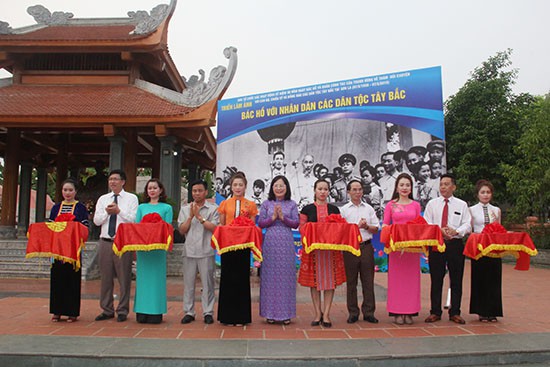
As many of 100 photos of Uncle Ho and northwestern ethnic people are on display at an exhibition which opened in Yen Chau district, the northwestern province of Son La, on May 8th.
The event was held by the Management Board of President Ho Chi Minh at
the Presidential Place, Son La provincial Department of Culture, Sports and
Tourism, and Yen Chau district People’s Committee, as part of a series of
activities to celebrate the 60th anniversary of Uncle Ho’s visit to the
Northwest region (May 7th, 1959-2019).
Exhibits were chosen
from different sources on Uncle Ho’s visit and talks with cadres, soldiers and
compatriots in Son La province. They deeply reflected Uncle Ho’s love and the
Party and State’s care for northwestern ethnic groups, and the achievements of
60 years’ implementation of Uncle Ho’s teachings in socio-economic and cultural
fields in Yen Chau district.
The exhibition
contributed to teach the national historical tradition, cultivate and uphold
the spirit of patriotism, and arouse the creativity of party committees,
authorities, officials, party members, soldiers of armed forces and ethnic
people in Son La in general and Yen Chau in particular./.
Source: DCS
With an increasingly vibrant and widespread emulation movement aimed at building cultured residential areas and cultured families, Yen Thuy District has been making steady progress toward improving both the material and spiritual well-being of its people, while fostering a civilized, prosperous, beautiful, and progressive community.
Once lacking recreational spaces and community facilities, Residential Group 2 in Quynh Lam Ward (Hoa Binh City) has recently received attention for the construction of a new, spacious, and fully equipped cultural house. The project followed the model of state support combined with public contributions in both labor and funding.
The "All people unite to build cultural life" movement, which has been effectively integrated with Kim Boi district’s socio-economic development goals, is fostering a lively spirit of emulation across local residential areas, hamlets, villages, public agencies, and enterprises. In addition, through the initiative, traditional cultural values are being preserved and promoted, while community solidarity and mutual support in poverty reduction and economic development are being strengthened.
A working delegation of the Hoa Binh provincial People’s Committee led by its Permanent Vice Chairman Nguyen Van Toan on June 11 inspected the progress of a project to build the Mo Muong Cultural Heritage Conservation Space linked to tourism services in Hop Phong commune, Cao Phong district.
Born and growing in the heroic land of Muong Dong, Dinh Thi Kieu Dung, a resident in Bo town of Kim Boi district, in her childhood was nurtured by the sweet lullabies of her grandmother and mother. These melodies deeply imprinted on her soul, becoming an inseparable part of her love for her ethnic group's culture. For over 20 years, this love for her hometown has driven Dung to research, collect, and pass down the cultural values of the Muong people to future generations.
In the final days of May, the Ethnic Art Troupe of Hoa Binh Province organized performances to serve the people in remote, mountainous, and particularly disadvantaged areas within the province. These were not just ordinary artistic shows, but they were the meaningful journeys aimed at spreading cultural values, enhancing the spiritual life of the people and contributing to the preservation of ethnic minority cultural identities.


